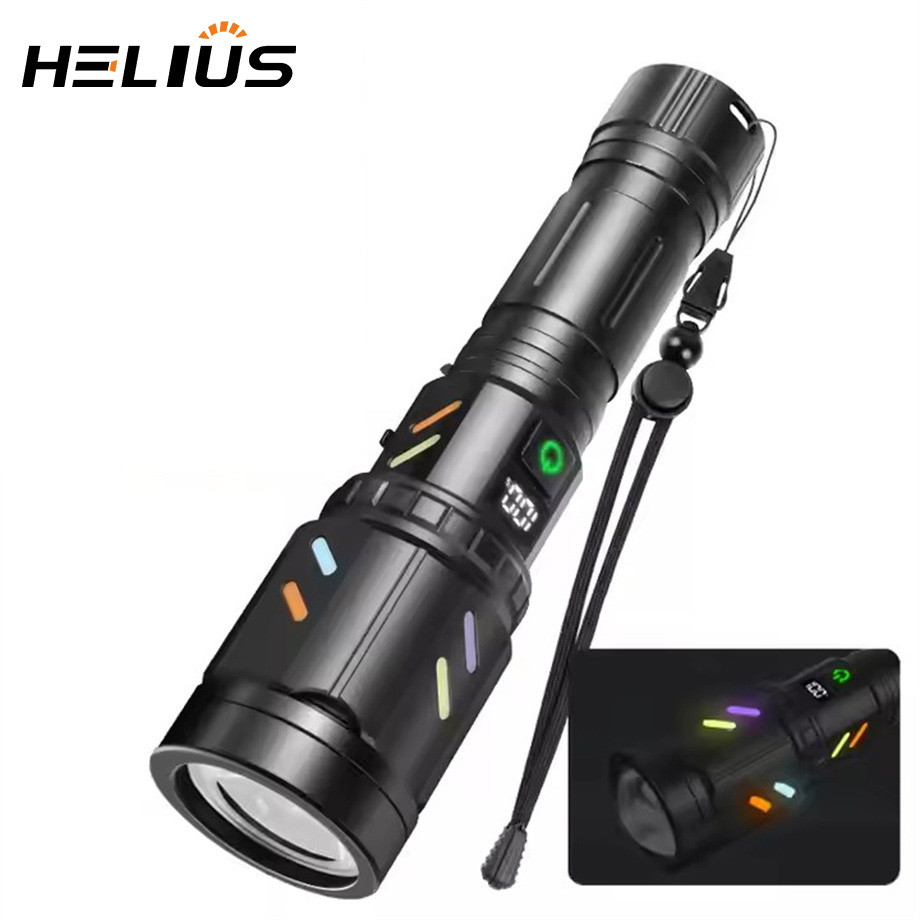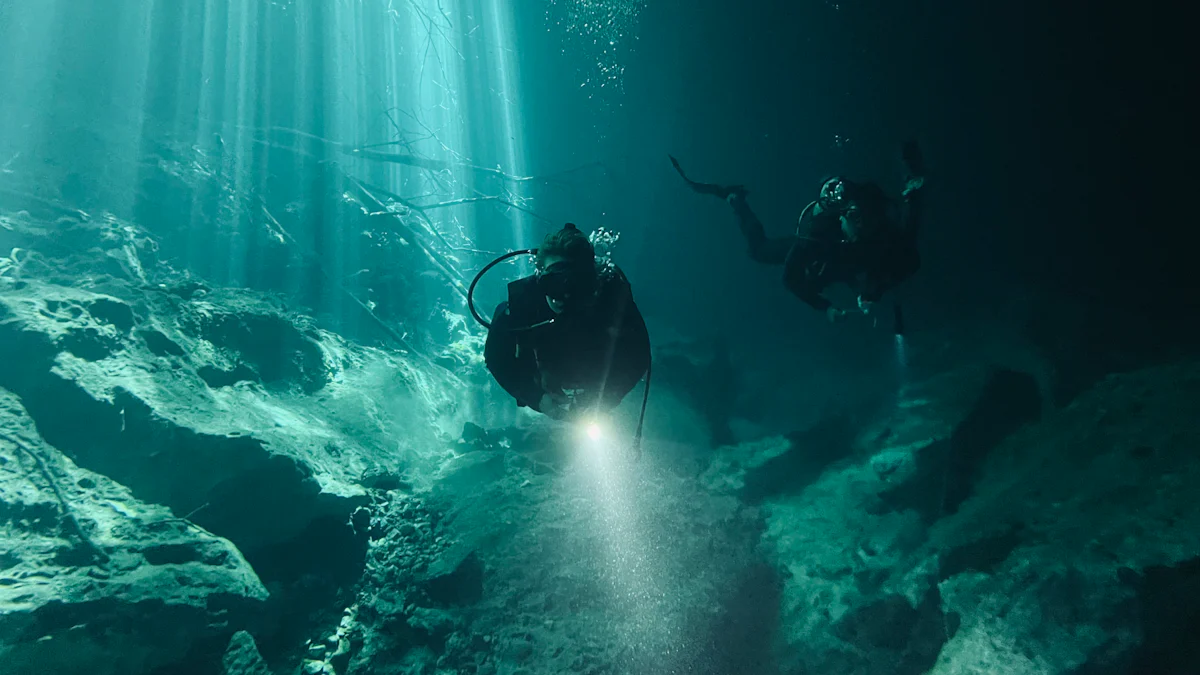Specialized Flashlights for Underwater Activities

Specialized flashlights for underwater activities are essential tools for divers. These flashlights are designed to function in challenging underwater environments. They provide reliable illumination, ensuring you can see clearly during dives. Without proper lighting, navigating underwater becomes risky, especially in low-visibility conditions. Using non-specialized flashlights can lead to equipment failure. Regular flashlights lack the waterproofing and durability needed for diving. For example, specialized flashlights often feature higher waterproof ratings, corrosion-resistant materials, and adjustable brightness levels. These features make them indispensable for safe and enjoyable underwater exploration.
Key Takeaways
Special diving flashlights are important for safe underwater adventures. They give steady light in dark waters, lowering dangers while diving.
Pick flashlights with strong waterproofing and tough materials. These help them last longer and work well underwater.
Select the right brightness for your dive. Fun divers need 200-500 lumens, but deep divers might need 1000 lumens or more for very dark spots.
Think about the beam type you need. Thin beams are great for caves, and wide beams are better for open water to see more clearly.
Take care of your flashlight to make it last. Wash it with clean water after diving and check O-rings to stop leaks.
Key Features of Diving Flashlights

Waterproofing and Depth Ratings
Importance of waterproofing
Waterproofing is a critical feature in diving flashlights. It ensures that your flashlight remains functional even when fully submerged. Manufacturers use robust seals and gaskets to prevent water from entering the flashlight. These components undergo rigorous testing to meet strict waterproofing standards. For example, hydrostatic pressure testing evaluates how well the flashlight performs under water pressure. This testing guarantees reliability, so you can trust your flashlight during dives.
Attribute | Measurement Method | Impact | Testing Score |
|---|---|---|---|
Waterproof Rating | Hydrostatic pressure testing | Direct safety implication – failure causes flooding | Safety (3/3), Function (3/3), Usage (3/3), Measurability (3/3) |
O-ring Design | Pressure cycling and seal integrity testing | Critical for preventing water ingress | Safety (3/3), Function (3/3), Usage (2/3), Measurability (2/3) |
Understanding depth ratings
Depth ratings indicate how deep a flashlight can go without losing functionality. For recreational diving, you need a flashlight rated for depths of up to 130 feet (40 meters). Technical diving requires flashlights that can handle depths of up to 492 feet (150 meters). Always check the depth rating to match your diving needs.
Diving Type | Depth Range (m) | Depth Range (ft) |
|---|---|---|
Shallow Water | 0-20 | 0-65 |
Recreational | 20-40 | 65-130 |
Technical | 40-150 | 130-492 |
Brightness and Beam Types
Role of lumens in underwater visibility
The brightness of dive lights is measured in lumens. Higher lumens provide better visibility in dark underwater environments. For recreational dives, 200-500 lumens are sufficient. However, technical divers may require flashlights with 1000 lumens or more. Brightness ensures you can see clearly and navigate safely.
Narrow vs. wide beams
Beam type affects how light spreads underwater. Narrow beams focus light on a specific area, making them ideal for exploring caves or wrecks. Wide beams illuminate larger areas, which is useful for open-water diving or group activities. Choose the beam type based on your diving environment.
Durability and Materials
Corrosion-resistant materials
Diving flashlights must withstand harsh saltwater conditions. Materials like aluminum and stainless steel resist corrosion, ensuring long-term reliability. These materials prevent rust and deterioration, keeping your flashlight functional even after repeated exposure to saltwater.
Shockproof designs
Shockproof designs protect your flashlight from damage during accidental drops or impacts. Manufacturers test diving LED torches by dropping them from heights of up to 2 meters onto sand. They also expose them to saltwater for 30 days to ensure durability. These tests confirm that your flashlight can handle the challenges of underwater exploration.
Test Type | Test Parameters | Results |
|---|---|---|
Impact Resistance | 2m drop onto sand | All units passed |
Pressure Cycling | 0-150m × 100 cycles | No failures |
Salt Water Exposure | 30 days continuous | Minor oxidation |
Types of Dive Lights

Primary Dive Lights
Features and uses
Primary dive lights are your main source of illumination during dives. These torches are larger and brighter, providing consistent lighting for both daytime and nighttime underwater activities. They often feature a center-weighted beam, which helps you focus on specific areas, such as coral reefs or wrecks. Their long-lasting battery packs ensure you have sufficient power for extended dives. These diving flashlights are built to last, with durable materials that can withstand years of use in challenging underwater conditions.
Feature | Primary Dive Lights | Secondary Dive Lights |
|---|---|---|
Size | Larger | More compact |
Brightness | Brighter | Typically less bright |
Battery Pack | Large, long-lasting | Smaller, less powerful |
Beam Type | Center-weighted beam | Narrower beam |
Purpose | Used for daytime or nighttime dives | Backup in case primary light fails |
Grip Type | Pistol grip or lantern grip | Usually simpler grip |
Durability | Built to last at least a decade | Less emphasis on durability |
Power | Higher power preferred | Lower power |
Visibility Impact | Can cause white-out if too bright | Less impact on visibility |
Best practices
When using primary dive lights, always check the battery level before your dive. Adjust the brightness to avoid startling marine life or causing glare. Hold the torch with a steady grip, such as a pistol or lantern grip, for better control. Store it in a dry, cool place after use to maintain its longevity.
Secondary Dive Lights
Backup lights for emergencies
Secondary dive lights act as your backup in case your primary light fails. These diving flashlights are compact and lightweight, making them easy to carry during emergencies. Despite their smaller size, they often have a high lumen rating and long burn time. This ensures you have enough illumination to safely exit a dive. Their center-weighted beam enhances visibility, which is crucial in emergency situations.
Compact designs
Compact dive lights are ideal for portability. Their small size allows you to store them in a BC pocket or attach them to your gear. These torches are perfect for exploring tight spaces, such as reef crevices or under ledges. Many models use disposable batteries with a long shelf life, ensuring reliability when you need them most.
Video and Photography Lights
Lights for underwater footage
Video and photography lights are essential for capturing high-quality underwater footage. These lights offer features tailored to videography:
Brightness of at least 1500 lumens, with 2000 lumens or more preferred.
Wide beam angles (up to 120° in air) to avoid hot spots in images.
Run times of at least one hour at full power.
High color rendering index (CRI) above 80 for accurate color representation.
Safety features like gas-off valves to prevent overheating.
LED lights provide constant output, which is crucial for capturing moving scenes. Wide beams cover the entire video frame, making them ideal for wide-angle shots.
Color temperature considerations
Color temperature plays a significant role in underwater photography. It affects how colors appear in your images. Proper white balance settings help you achieve accurate color reproduction. Different water conditions, such as warm or cold water, can alter the perceived colors. Adjusting the white balance manually can enhance the quality of your photos at various depths.
How to Choose the Right Diving Flashlight
Matching Flashlight to Activity
Recreational diving and snorkeling
For recreational diving and snorkeling, you need a flashlight that balances brightness and portability. Look for lights with 200-500 lumens, which provide sufficient illumination for shallow waters. A wider beam angle works best in open water, offering better visibility in clear conditions. Ensure the flashlight has a waterproof rating of IPX8 or higher to handle submersion. Lightweight designs make it easier to carry during your underwater exploration.
Cave diving and technical diving
Cave diving and technical diving demand more robust flashlights. You need a narrow beam angle to focus light in confined spaces. Brightness levels of 1000 lumens or more are essential for navigating dark environments. Durability is critical, as these activities expose your gear to harsh conditions. Choose lights made from corrosion-resistant materials and ensure they have adjustable brightness settings for versatility.
Underwater photography
Underwater photography requires specialized lights. Wide-angle beams illuminate larger areas, reducing shadows and enhancing image quality. Color temperature plays a key role in capturing accurate colors. Look for lights with accessories like diffusers to soften the beam. These features ensure your photos and videos reflect the vibrant beauty of underwater life.
Battery Life and Power Options
Rechargeable vs. disposable batteries
Rechargeable batteries offer convenience and cost savings over time. They provide longer runtime and reduce waste, making them an eco-friendly choice. Many models allow you to adjust brightness levels to extend battery life. Disposable batteries, while less environmentally friendly, are easy to replace and ideal for emergencies.
Battery life for extended dives
Extended dives require flashlights with long battery life. Look for models with a runtime of at least two hours at full power. Carry spare batteries to avoid running out of light during night diving or wreck diving. High-quality rechargeable batteries ensure consistent performance.
Budget Considerations
Balancing cost and features
When choosing a flashlight, focus on the features you need for your diving activities. Higher-priced models often include advanced features like adjustable brightness and longer battery life. However, budget-friendly options can still meet basic requirements for recreational diving.
Recommendations for different budgets
For backup lights, consider options in the $30-$80 range with 150-450 lumens. Primary dive lights for recreational diving typically cost $100-$250 and offer 1000-2500 lumens. Advanced divers may prefer high-output lights priced at $300 or more, delivering 2500+ lumens for technical or wreck diving.
Choosing the right flashlight is essential for safe and enjoyable diving. A well-suited flashlight enhances visibility, helps you navigate underwater, and ensures you’re prepared for unexpected situations. Match your flashlight to your activity. For example, recreational diving benefits from wide beams, while technical diving requires narrow beams for focused illumination. Consider features like red light modes to preserve night vision and avoid startling marine life. Always prioritize quality and safety over cost. Seek guidance from experienced divers, and choose reliable equipment designed for underwater use. With the right flashlight, you can explore the underwater world with confidence.
FAQ
What makes diving flashlights different from regular flashlights?
Diving flashlights are designed for underwater use. They feature waterproof seals, corrosion-resistant materials, and high depth ratings. These features ensure reliability and durability in challenging underwater environments. Regular flashlights lack these capabilities, making them unsuitable for divers.
How do I maintain my diving flashlight?
Rinse your flashlight with fresh water after every dive. Dry it thoroughly before storing it in a cool, dry place. Check the O-rings regularly for wear and apply silicone grease to maintain their integrity. Proper care ensures your flashlight lasts longer.
Can I use one flashlight for all types of diving?
Not all flashlights suit every diving activity. Recreational divers need wide beams for open water, while technical divers require narrow beams for caves or wrecks. Underwater photographers benefit from lights with high lumens and adjustable color temperatures. Match your flashlight to your specific needs.
How do I choose the right brightness level for my dives?
Brightness depends on your diving environment. For recreational dives, 200-500 lumens work well. Technical divers exploring dark areas need 1000 lumens or more. Avoid overly bright lights in clear water to prevent glare or disturbing marine life.
Are rechargeable batteries better for diving flashlights?
Rechargeable batteries offer longer runtimes and reduce waste, making them ideal for frequent divers. Disposable batteries are convenient for emergencies or occasional use. Always carry spares to ensure uninterrupted illumination during your dives.
See Also
Advantages of Buying Wholesale Diving Flashlights in Bulk
Understanding the Advantages of 365nm UV Flashlights
How to Choose the Ideal Flashlight or Headlamp
